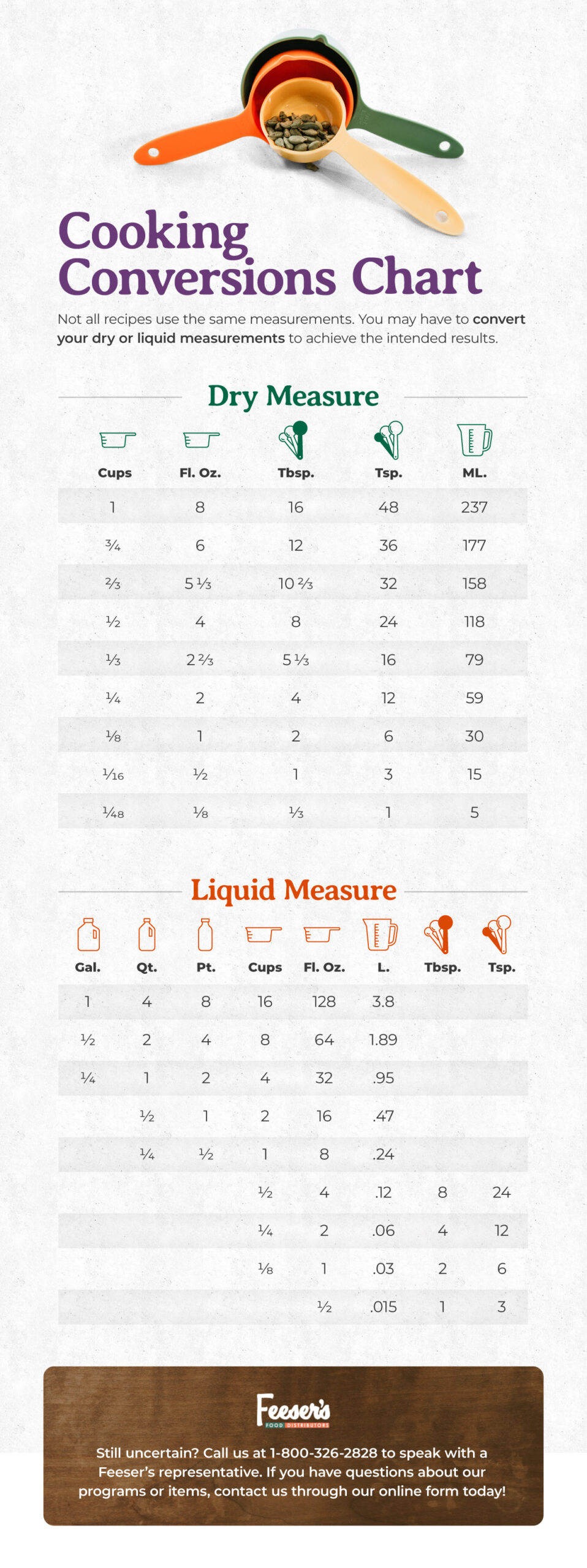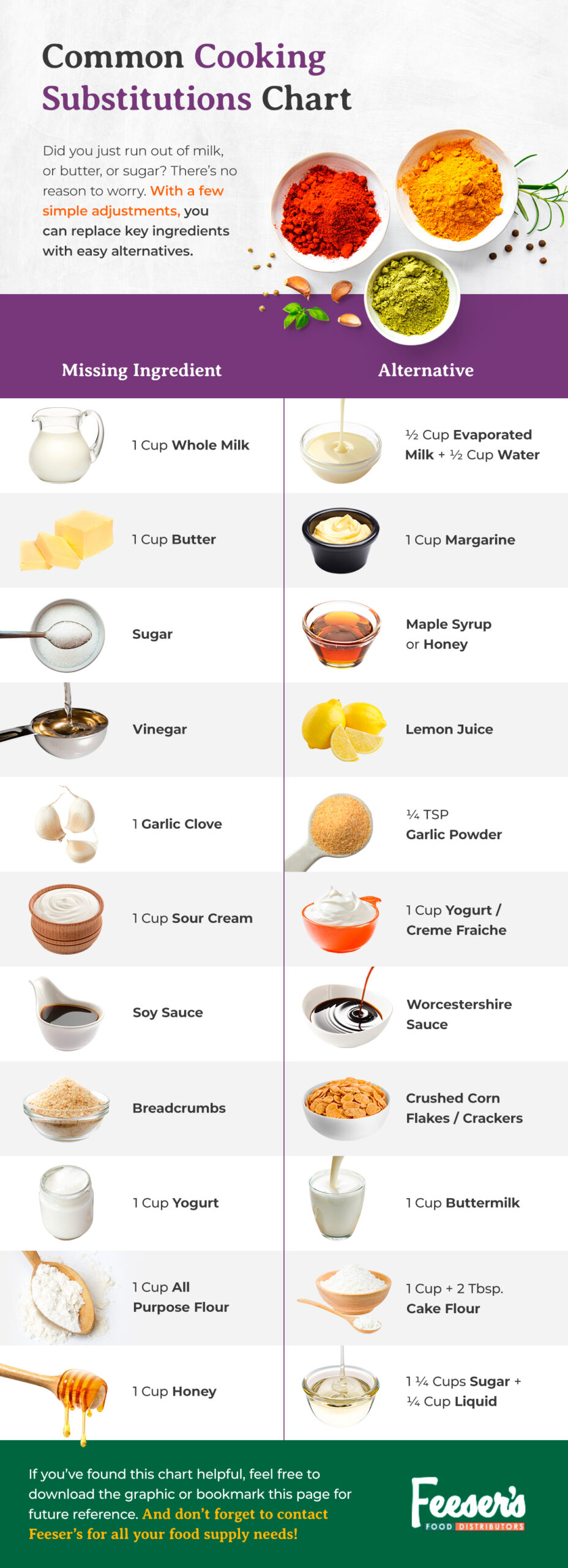Common Cooking Conversions & Substitutions
If you bake or cook, you know how easy it is to jump into a recipe without pausing to read the ingredient list or instructions thoroughly. While you can memorize many things, trying to remember a conversion for an unexpected unit of measurement or wondering whether you have that specific ingredient on hand can make even the most seasoned cook pause.
Instead of scrapping the work you’ve already put in, you have options to replace the ingredients you’re missing. Regardless if you’re doubling a recipe or converting from metric to cups, these handy charts will allow you to convert and substitute everyday ingredients with confidence:
Common Measurement Conversions for Dry and Wet Ingredients
Nothing can stop a delicious recipe in its tracks like needing to convert measurements. To help make your cooking process easier, we’ve created a cooking and baking conversion chart:
Dry Ingredient Conversions
- 3 teaspoons=1 tablespoon=1/2 ounce=14.3 grams
- 2 tablespoons=1/8 cup=1 fluid ounce=28.3 grams
- 4 tablespoons=1/4 cup=2 fluid ounces=56.7 grams
- 5 1/3 tablespoons=1/3 cup=2.6 fluid ounces=75.6 grams
- 8 tablespoons=1/2 cup=4 ounces=113.4 grams=1 stick butter
- 12 tablespoons=3/4 cup=6 ounces=.375 pound=170 grams
- 32 tablespoons=2 cups=16 ounces=1 pound=453.6 grams
- 64 tablespoons=4 cups=32 ounces=2 pounds=907 grams
Liquid Ingredient Conversions
- 1 cup=8 fluid ounces=1/2 pint=237 ml
- 2 cups=16 fluid ounces=1 pint=474 ml
- 4 cups=32 fluid ounces=1 quart=946 ml
- 2 pints=32 fluid ounces=1 quart=946 ml
- 4 quarts=128 fluid ounces=1 gallon=3.784 liters
- 8 quarts=one peck
- 4 pecks=one bushel
- Dash=less than 1/4 teaspoon
Fluid ounces on the outside of a liquid measuring cup are not the same as a weighted ounce. A fluid ounce measures volume while ounces measure weight. While you can use dry measuring cups, it will make a difference in the outcome of your recipe, especially for baked goods.
Common Ingredient Alternatives
Here’s a list of ingredients and their substitutions that you may already have in your kitchen:
- Whole milk: If your recipe calls for a cup of whole milk that you don’t have, don’t fret. Mix ½ cup of evaporated milk and ½ cup of water to get the same flavor and consistency.
- Butter: Whether you want to make your recipe a little healthier or you used the last of your butter the night before, margarine is an easy alternative. If you need a cup of butter, use a cup of margarine instead.
- Sugar: Honey and maple syrup are excellent sweeteners when you finish your white sugar. As a bonus, they can add a subtle flavor other than sweetness to your recipe.
- Vinegar: Lemon juice is a great substitution when your recipe calls for vinegar, but you don’t have any. The lemon juice adds the perfect amount of sourness and acidity your dish may need.
- Garlic clove: If you need a garlic clove but don’t have any fresh garlic, consider using garlic powder. Use ¼ teaspoon of garlic powder for one garlic clove. Garlic powder is made from ground, dehydrated garlic cloves, so you can use the same ingredient but in a different form.
- Sour cream: You can substitute a cup of sour cream with a cup of yogurt or crème fraîche. Both ingredients are cultured and provide a slightly acidic taste.
- Soy sauce: If you need the umami flavor of soy sauce but can’t find it in your house, Worcestershire sauce is an excellent alternative. It provides the tangy, savory and sweet taste you need for your dish.
- Breadcrumbs: When you need to add some crunch or use a binding agent for part of your dish, consider crushing crackers or corn flakes. They make wonderful alternatives for breadcrumbs when you don’t have any.
- Yogurt: While yogurt is an excellent substitute for sour cream and vice versa, another ingredient that works well is buttermilk. You can replace a cup of yogurt with a cup of buttermilk to have the same tanginess and creaminess in your recipe.
- All-purpose flour: You can use cake flour if you ever run out of all-purpose flour while baking. Use 1 cup and 2 tablespoons of cake flour to every cup of all-purpose flour called for in your recipe.
- Honey: Just like replacing sugar with honey, you can use sugar as a honey substitute. For every cup of honey, use a mixture of 1 ¼ cup of sugar and ¼ cup of liquid.
Tackle Your Next Recipe With Confidence
After gathering ingredients or some items to have on hand for substitutes with Feeser’s Food Distributors, bookmark this page and download our common substitutions and cooking conversion chart graphics to have on hand for future reference.
Feeser’s is a family-owned, central PA-based business that has been helping restaurants and businesses in the mid-Atlantic region make memorable meals for over 120 years. Start partnering with Feeser’s today and source the products or services you need to successfully run a restaurant or call us at 1-800-326-2828.


